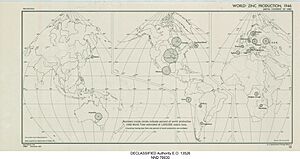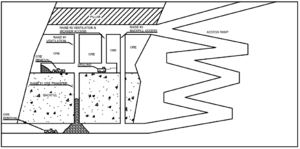Zinc mining facts for kids

Zinc mining is how we get the metal zinc from the ground. A zinc mine is a place where zinc minerals are the main thing being dug up. Often, mines that produce zinc also find other metals like lead and silver. Sometimes, zinc is found as a bonus when miners are looking for more valuable metals like gold or copper.
After the ore (rock with minerals) is dug up, it's usually processed right there at the mine. This makes a concentrated material rich in metal. This concentrate then goes to a special factory called a zinc smelter. There, the pure zinc metal is made.
In 2020, the world produced about 12 million tonnes of zinc from mines. The biggest producers were China (35%), Australia (12%), and Peru (10%). The Red Dog mine in Alaska is the world's largest zinc mine. It produces about 4.2% of all zinc. Big companies like Vedanta Resources and Glencore operate many of these mines.
Contents
How People Have Mined Zinc Through History
People have been using zinc for thousands of years. The oldest known zinc mine is in Rajasthan, India, and it started almost 2000 years ago.
Pure zinc was first made in India around the 800s AD. Before that, zinc was mostly used to mix with copper to make brass. Getting pure zinc from its ore is tricky. When zinc is heated enough to separate from the rock, it turns into a gas. If the furnace isn't sealed, the zinc gas mixes with air and turns back into zinc oxide.
After India, China started making metallic zinc about 300 years later. Europe began producing it much later, around 1738 AD.
Today, zinc has many important uses. Almost half of all zinc produced is used to coat iron and steel. This process, called galvanization, stops the metal from rusting. About 20% of the world's zinc goes into making brass. The rest is used in other ways, like in different metal mixtures (alloys) with aluminium and magnesium. It's also used in farming as a fertilizer and even as a supplement for people.
How Zinc Is Dug Up
Zinc is mined both from the surface and deep underground. Surface mining is usually for zinc oxide ores. Underground mining is for zinc sulfide ores. Here are some common ways zinc is mined:
Open-Pit Mining
This is a type of surface mining. First, miners remove the dirt and rock that cover the ore. This is called "waste rock" or "overburden." Once the ore is uncovered, they use large excavators and trucks to dig out the ore and any remaining waste rock. For smaller operations, front loaders might be used.
Open Stope Mining
This is an underground mining method. Miners dig out large sections of ore, leaving big empty spaces called "stopes." These stopes are left without extra support. Instead, some pillars of ore are left behind to help hold up the walls of the cavern.
Cut and Fill Mining
This is another underground method. Miners remove ore from below the deposit. After the ore is taken out, the empty space (the stope) is filled with waste rock. This waste rock helps support the walls of the stope. It also creates a higher floor for miners and their equipment to continue digging out more ore.
How Much Zinc Is Produced
In 2019, the world produced 12.9 million tonnes of zinc from mines. This was a small increase from 2018, mainly because of more production in Australia and South Africa.
Experts thought that in 2020, zinc production would go up to 13.99 million tonnes. This increase was expected because China and India were producing more zinc.
In 2019, the world needed more refined zinc than was available, leading to a small shortage. However, in 2020, there was expected to be a small surplus of zinc.
Here are the top countries that produced zinc in 2019:
| Country | Output (million tonnes) | Share of world production |
|---|---|---|
| China | 4.371 | 34% |
| Peru | 1.404 | 11% |
| Australia | 1.283 | 10% |
| USA | 0.795 | 6.1% |
| India | 0.712 | 5.5% |
| Mexico | 0.703 | 5.4% |
| Bolivia | 0.46 | 3.5% |
| Canada | 0.339 | 2.6% |
| Other Countries | 2.83 | 22% |
How Zinc Mining Affects the Environment
Studies have looked at how zinc mining affects the environment, especially in places like southeastern Missouri in the US. Researchers found fewer fish and crayfish near mining sites compared to other areas. The crayfish that were found had much higher levels of metals in their bodies.
Mussel populations near lead-zinc mining areas were also smaller and had less variety. Plants in these areas had 10-60% more metals in their tissues. Areas right downstream from mining activity showed a drop in healthy living conditions. The ecosystem's ability to support its animal populations was also harmed.
Small creatures like crayfish and mussels are important because they can show how pollution moves up the food chain. When bigger animals eat these contaminated smaller creatures, the harmful materials build up in their bodies. These small creatures are also often used as signs of how healthy an ecosystem is overall.
Research in farming areas near a lead-zinc mining region in Guangxi, China, found serious zinc pollution in the soil. The soil closer to the mine had "serious pollution," while areas further away had "moderate pollution." This research showed that these areas were not good for farming. Another study in the Heilongjiang Province of China found that soils were "moderately contaminated." This led to fewer types of bacteria and less activity from soil enzymes. These bacteria and enzymes help plants get nutrients and break down decaying matter. When they are reduced, farming becomes less productive.
Major Zinc Mines Around the World
Here are the ten biggest zinc-producing mines in the world by how much zinc they produce:
| Name of the mine | Owner | Production tonnes |
Operations |
|---|---|---|---|
| Red Dog (USA) | Teck Resources | 552,400 (2019) |
open-pit zinc-lead-silver mine |
| Rampura Agucha (India) | Vedanta Resources (64.9%) Government of India (29.5%) |
357,571 (2019) |
underground zinc-lead-silver mine |
| Mount Isa (Australia) | Glencore | 326,400 (2019) |
George Fisher and Lady Loretta underground lead-zinc-silver mines |
| Antamina (Peru) | BHP (33.75%), Glencore (33.75%), Teck Resources (22.5%), Mitsubishi Corporation (10%) |
303,555 (2019) |
open-pit copper-zinc-molybdenum mine |
| McArthur River (Australia) | Glencore | 271,200 (2019) |
open-pit zinc-lead-silver mine |
| San Cristóbal (Bolivia) | Sumitomo Corporation | 206,100 (2019) |
open-pit silver-lead-zinc mine |
| Dugald River (Australia) | China Minmetals | 170,057 (2019) |
underground cut and fill stoping |
| Vazante (Brazil) | Nexa Resources | 139,000 (2019) |
underground and open pit zinc-lead-silver mine |
| Cerro Lindo (Peru) | Nexa Resources | 126,000 (2019) |
underground zinc-lead-copper-silver mine |
| Tara (Ireland) | Boliden AB | 122,463 (2019) |
underground zinc-lead mine |
See Also
- Zinc mining in the United States



